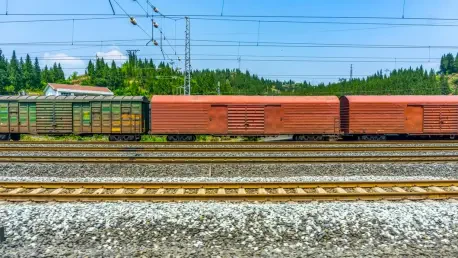Setting the Stage: A Transformative Shift in Rail Freight
Imagine a freight landscape where delays at interchanges vanish, transit times shrink, and rail becomes the go-to choice over trucking for shippers across the United States. This vision drives the proposed merger between Union Pacific (UP) and Norfolk Southern (NS), two giants of the Class I railroad sector, aiming to revolutionize operations through single-line service. The promise of seamless, single-carrier transport has ignited debate among industry stakeholders, with projections of massive synergies and market share gains fueling optimism. Yet, beneath the surface lies a critical question: can this transition truly deliver the competitive edge needed to reshape the market? This market analysis delves into the intricacies of the UP+NS merger, dissecting historical trends, current data, and future projections to assess whether single-line service holds the key to sustained growth or remains an unproven gamble in a fiercely competitive freight ecosystem.
Deep Dive into Market Trends and Data
Historical Performance: Uneven Gains from Single-Line Models
The rail industry has long pursued consolidation to boost efficiency, with single-line service positioned as a cornerstone of past mergers. Historically, the concept aimed to eliminate the bottlenecks of interline arrangements, where multiple carriers coordinate handoffs, often leading to delays. Examining data from the last two decades, Union Pacific’s single-line carload tonnage (excluding intermodal, coal, and grain) reflects a slight edge, growing at a 1% compound annual growth rate (CAGR), compared to a mere 0.3% for interline traffic. In contrast, Norfolk Southern faced declines, with single-line tonnage dropping at a -1.6% CAGR, influenced by operational hiccups and strategies like Precision Scheduled Railroading (PSR) that favored cost-cutting over volume. These disparities reveal a fundamental truth: while single-line service offers theoretical advantages, its success hinges on execution and external market conditions, casting doubt on its reliability as a universal growth driver.
Commodity-Specific Insights: A Fragmented Picture
Breaking down performance by commodity uncovers further complexities in the single-line narrative. In the intermodal sector, critical for competing with trucking, Union Pacific saw single-line tonnage decline at a -2.5% CAGR, with interline faring worse at -3.3%, signaling a loss of freight to highways. Norfolk Southern, however, achieved a 1.4% CAGR in single-line intermodal, hinting at potential lessons for UP post-merger. Automotive traffic, often reliant on interline due to complex routing, presents another challenge, with UP’s single-line tonnage falling at a -2.3% CAGR, outpaced by interline’s -1.2%. Meanwhile, chemicals—a rail-friendly commodity due to safety and distance factors—showed strength for UP with a 3.3% CAGR in single-line growth, far surpassing interline’s 0.6%. These varied outcomes underscore that single-line service does not guarantee market share expansion across all sectors, with success tied to specific commodity dynamics and operational strategies.
Projections and Synergies: Ambitious Targets Under Scrutiny
Looking ahead, the UP+NS merger stakes bold claims, projecting $1.75 billion in EBITDA synergies and a 10% increase in freight loads, equating to 1.55 million additional loads by 2030. The rationale centers on streamlined operations through single-line service, reducing transit times and enhancing reliability to attract shippers from trucking. However, market analysts caution that these figures may overestimate the impact, given historical inconsistencies in single-line performance. The competitive landscape remains dominated by trucking, which offers unmatched flexibility and entrenched relationships with shippers. Without targeted engagement and proof of reliability, the projected shift of freight from highways to rail risks falling short, particularly in service-sensitive sectors like intermodal and automotive where past trends show persistent declines.
External Pressures: Trucking Dominance and Regulatory Hurdles
Beyond internal data, external forces shape the merger’s potential outcomes. Trucking continues to hold a significant edge in flexibility, with shippers often prioritizing speed and adaptability over cost savings from rail. This entrenched preference poses a barrier to achieving the projected market share gains, as convincing shippers to switch requires more than just operational tweaks—it demands a cultural shift in logistics planning. Additionally, regulatory oversight from the Surface Transportation Board (STB) adds complexity, as approval hinges on demonstrating public benefits like reduced highway congestion. Balancing these external challenges with internal integration risks, such as service disruptions during the merger process, will be critical to realizing any single-line advantages in the marketplace.
Reflecting on the Path Forward: Strategic Lessons from the Analysis
Looking back, this market analysis revealed that the UP+NS merger, while ambitious, faces a landscape of mixed historical performance and uncertain projections. The data paints a fragmented picture, where single-line service occasionally outperforms interline models but often falls short in key sectors like intermodal and automotive. Ambitious targets of $1.75 billion in synergies and a 10% load increase by 2030 appear optimistic against the backdrop of trucking’s dominance and regulatory scrutiny. Moving forward, the strategic focus needs to pivot toward leveraging strengths, such as Norfolk Southern’s intermodal expertise, to bolster weaker areas. Targeted investments in shipper outreach and technology, like real-time tracking systems, offer a pathway to build trust and reliability. Ultimately, the rail industry must adapt to a freight ecosystem where single-line service is just one piece of a larger puzzle, requiring innovation and persistence to shift market dynamics in its favor.









